
Mathematics, 14.06.2021 15:50 emily12403
One of the questions Rasmussen Reports included on a 2018 survey of 2,500 likely voters asked if the country is headed in right direction. Representative data are shown in the DATAfile named Right Direction. A response of Yes indicates that the respondent does think the country is headed in the right direction. A response of No indicates that the respondent does not think the country is headed in the right direction. Respondents may also give a response of Not Sure.
(a) What is the point estimate of the proportion of the population of respondents who do think that the country is headed in the right direction?
(b) At 95% confidence, what is the margin of error for the proportion of respondents who do think that the country is headed in the right direction?
(c) What is the 95% confidence interval for the proportion of respondents who do think that the country is headed in the right direction?
(d) What is the 95% confidence interval for the proportion of respondents who do not think that the country is headed in the right direction?
(e) Which of the confidence intervals in parts (c) and (d) has the smaller margin of error? Why?
The confidence interval in part (c) has a (Smaller or Larger) margin of error than the confidence interval in part (d). This is because the sample proportion of respondents who do think that the country is headed in the right direction is (closer to .5 / closer to 1 / farther from .5 / farther from 1) than the sample proportion of respondents who do not think that the country is headed in the right direction.
Dataset:
553 - No
70 - Not Sure
384 - Yes

Answers: 1


Another question on Mathematics


Mathematics, 21.06.2019 20:30
For g(x) = 5x - 3 and h(x) = [tex]\sqrt{x}[/tex], find (g · h)(4)
Answers: 1

Mathematics, 21.06.2019 23:30
How do you write 600 as a product of its prime factors (index! )
Answers: 1

Mathematics, 21.06.2019 23:30
Consider the sequence below. 3 , 1 , 1/3 , 1/9 , select the explicit function which defines the sequence.
Answers: 1
You know the right answer?
One of the questions Rasmussen Reports included on a 2018 survey of 2,500 likely voters asked if the...
Questions








Computers and Technology, 22.06.2021 23:30





Computers and Technology, 22.06.2021 23:30





Mathematics, 22.06.2021 23:30

Mathematics, 22.06.2021 23:30

Advanced Placement (AP), 22.06.2021 23:30




